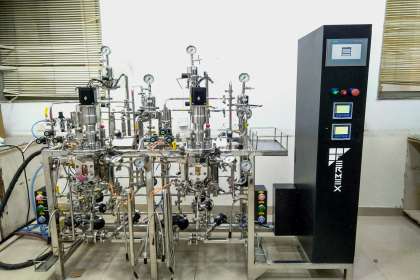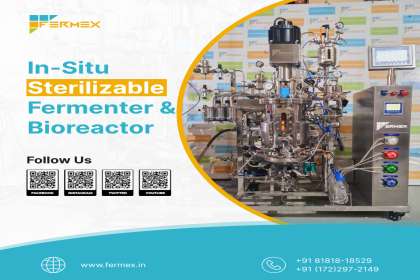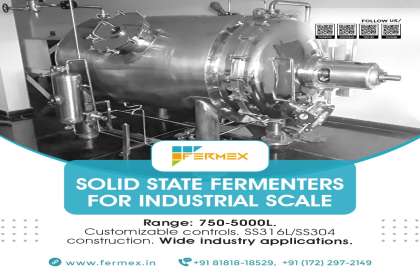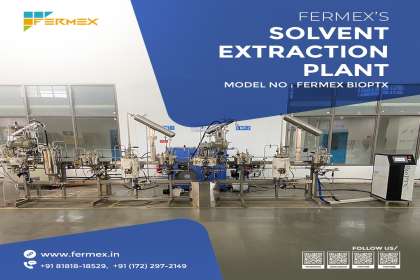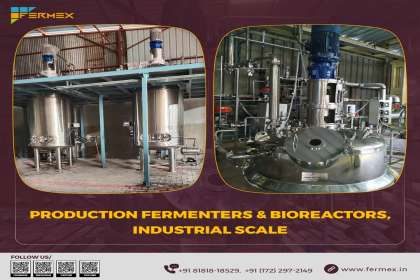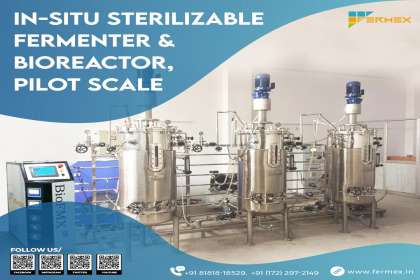
Fermenters play a crucial role in biomass production, particularly in the context of biotechnology and bioengineering. Biomass refers to organic matter derived from living organisms, and it can be used to produce a wide range of valuable products, such as biofuels, bioplastics, enzymes, pharmaceuticals, and various chemicals.
Fermenters, also known as bioreactors, are specialized vessels designed to support and optimize the growth of microorganisms or cells that produce biomass through fermentation processes.
Key Stages involve in Process of Making Biomass using Fermenter
The process of making biomass using a fermenter involves several key stages.
Here are the primary stages:
- Inoculum Preparation: The first step is to prepare an inoculum, which is a small quantity of the desired microorganism (bacteria, yeast, fungi, or algae) that will be used to initiate the fermentation process. The inoculum is usually grown in a separate vessel under controlled conditions to ensure it is healthy and actively growing.
- Fermenter Setup and Sterilization: The fermenter is set up with the appropriate culture medium, which contains the necessary nutrients for the microorganism’s growth. Before introducing the culture medium, the fermenter and all its components are thoroughly sterilized to ensure aseptic conditions. Sterilization prevents contamination from unwanted microorganisms that could compete with or inhibit the growth of the desired biomass-producing microorganism.
- Inoculation: The prepared inoculum is introduced into the sterilized fermenter, effectively “seeding” the culture medium with the desired microorganism. This step initiates the fermentation process.
- Fermentation: This is the main stage of biomass production. The microorganism grows and metabolizes the nutrients in the culture medium, converting them into biomass and other valuable products. The conditions inside the fermenter, such as temperature, pH, dissolved oxygen, and agitation rate, are carefully controlled to optimize the growth of the microorganism and the production of biomass.
- Monitoring and Control: Throughout the fermentation process, various parameters are continuously monitored to assess the progress of the culture. Biomass concentration, pH, dissolved oxygen levels, and other relevant factors are checked regularly. Based on this data, adjustments to the fermentation conditions can be made to ensure the process remains optimal.
- Harvesting: Once the desired biomass concentration is achieved, the fermentation is considered complete. The biomass-containing broth is harvested from the fermenter. Depending on the application, the harvested biomass might undergo additional processing steps for downstream purification and product extraction.
- Downstream Processing: After harvesting, the biomass may undergo further processing to extract the desired product or separate it from other components in the broth. This stage can include filtration, centrifugation, chromatography, and other separation techniques.
- Product Recovery: The final stage involves recovering the desired biomass product. This product can be in the form of biofuels, enzymes, bioplastics, pharmaceuticals, or other valuable compounds, depending on the specific microorganism and fermentation process.
Fermex Solutions LLP manufactures fermenters that can be used for these production.
Benefits of Fermenters in the production of Biofertilizer
Fermenters offer numerous benefits in the production of biomass, making them essential tools in biotechnology and bioengineering processes. Some of the key advantages include:
- Controlled Environment: Fermenters provide a controlled environment for microbial cultivation. Parameters such as temperature, pH, dissolved oxygen, and agitation rate can be precisely regulated, ensuring optimal conditions for the growth and metabolism of microorganisms. This control leads to higher biomass yields and better consistency in production.
- Scalability: Fermenters are available in various sizes, ranging from small laboratory-scale to large industrial-scale vessels. This scalability allows for the easy transfer of processes from research and development to commercial production. As the demand for biomass-derived products increases, fermenters can be adapted to accommodate larger volumes, meeting market needs efficiently.
- Efficiency in Biomass Production: Fermenters enable efficient conversion of substrates (e.g., sugars, starches, and cellulose) into biomass and other valuable products. The controlled environment and optimized conditions within the fermenter promote the rapid and robust growth of microorganisms, leading to higher biomass yields in shorter time frames.
- Product Diversification: The versatility of fermenters allows for the production of a wide range of biomass-derived products. Depending on the selected microorganism and culture conditions, fermenters can produce biofuels, bioplastics, enzymes, pharmaceuticals, organic acids, and other valuable chemicals.
- Reduced Resource Consumption: Fermenters offer a more resource-efficient approach to biomass production compared to traditional agricultural methods. They can use various feedstocks, including agricultural waste, lignocellulosic materials, and other renewable resources, reducing the demand for arable land and water.
- Continuous and Batch Production: Fermenters can operate in continuous or batch mode. Continuous fermentation allows for a steady output of biomass and reduces downtime between batches, enhancing overall productivity. Batch fermentation is suitable for smaller-scale production or when specific product characteristics require discrete batches.
- Sterility and Reduced Contamination: Fermenters are designed to maintain sterility throughout the fermentation process. This reduces the risk of contamination from unwanted microorganisms, ensuring the purity and consistency of the biomass product.
- Process Monitoring and Control: Fermenters are equipped with sensors and control systems to continuously monitor various parameters, enabling real-time adjustments and optimization of the fermentation process. This ensures stable and predictable production outcomes.
- Sustainable and Green Technology: Biomass production using fermenters is considered a more sustainable and environmentally friendly approach compared to fossil fuel-based industries. It contributes to reducing greenhouse gas emissions and dependence on non-renewable resources.
- Bioeconomy and Circular Economy: The use of fermenters in biomass production supports the growth of the bioeconomy, where renewable biological resources are utilized to replace fossil-based products. Additionally, the circular economy principles can be applied, where waste streams from one fermentation process can become feedstocks for another, creating a more closed-loop and resource-efficient system.








